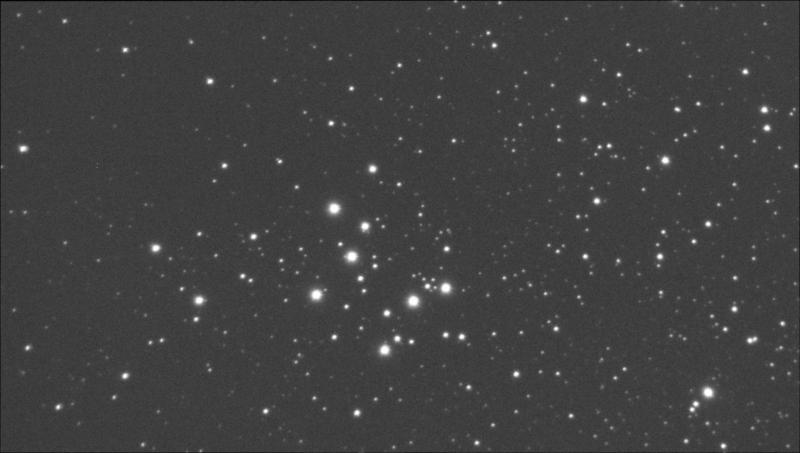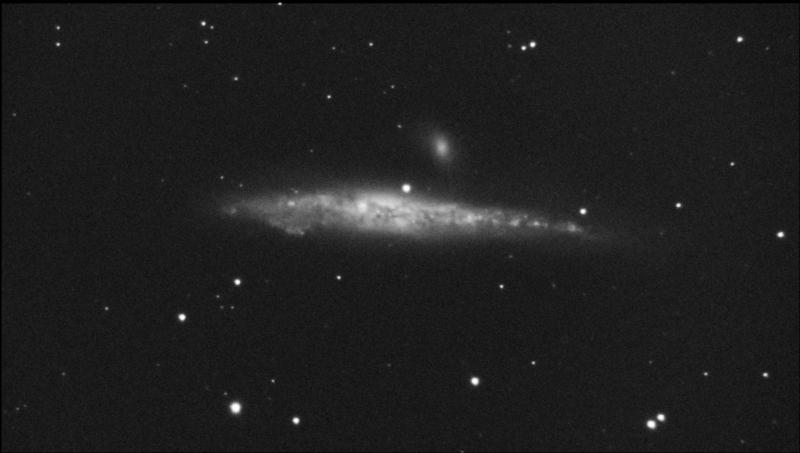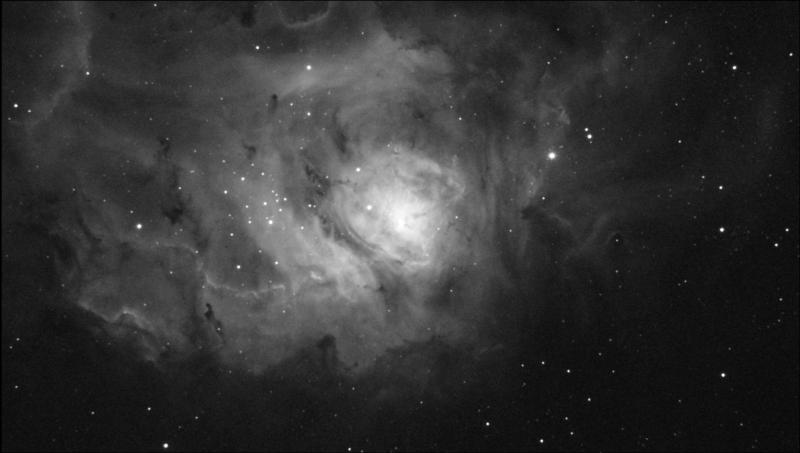July EAA Targets
Summary Easy: M29, NGC4631/4627, M20 and M8; Intermediate: NGC4567/4568, NGC5394/5395, M100 and NGC6888; Difficult: IC1340, NGC7380 and Sh2-132; Deep Southern: NGC6334 and NGC6357.
Easy: M29 (Cooling Tower) (20h 25m / +38d 36'), NGC4631/4627 (Whale Galaxy and pup) (12h 43m / +32d 25'), M20 (Trifid Nebula) (18h 04m / -22d 58') and M8 (Lagoon Nebula) (18h 05m / -24d 23') - Note: approximate JNOW co-ordinates.
M29 (Cooling Tower)
This small open cluster about 4000 light years distant in Cygnus is visible in the East after it gets dark and is an easy target for almost any set-up. M29 has about 50 members, but the brightest 5 stars making up part of the "Cooling Tower" are blue giants. The cluster is partially obscured by interstellar dust, and would otherwise be brighter. Here is a monochrome capture with my C8 @ f/3.7 (twin f/6.3 reducers) and an ASI290MM mini, with ASILive at 300 gain:
 |
M29 (Cooling Tower, C8); 5 x 10s |
NGC4631/NGG4627 (Whale Galaxy)
Visible in the west after dark as galaxy season is winding down, the Whale (or Herring) Galaxy, NGC4631 is a large and bright edge on spiral about 25 million light years away in Canes Venatici. It has a small companion galaxy (NGC4627) which, on very deep pictures shows a tidal connection. Dark dust clouds and bright star forming regions in the disk of the Whale are visible in this capture (same C8 set-up as above):
 |
NGC4631/NGC4627 (Whale Galaxy, C8); 12 x 25s |
M8 (Lagoon Nebula)
The Lagoon Nebula is a large emission nebula about 5200 light years away in Sagittarius. It features an embedded open cluster (NGC6530) of massive stars, which are the source of ionization of the gas in the cloud, as well as dark globules of protestellar material throughout. There are several structures with the Lagoon that deeper views will show. Here is a recent 5 minute capture with a 72mm AT72EDII APO operating at f/4.3, using a 7nm H-alpha filter and ASI290MM at high gain. The H-alpha view shows many details in the nebula, including dark globules silhouetted against the nebulosity. This is a great target for a one shot colour camera due to its brightness.
 |
| M8 (Lagoon Nebula, H-alpha, AT72EDII); 12 x 25s |
M20 (Trifid Nebula)
The Trifid Nebula is another emission nebula in Sagittarius, about 2 degrees from the larger and brighter Lagoon Nebula. It includes an open cluster at its centre and consists of a central emission nebula surrounded by a reflection nebula at a greater radial distance, and dark nebula giving it its distinctive pie-like appearance. Colour images show both the reflection nebula strongly in blue, and the H-alpha emission regions in red. Here are a couple of different views of the Trifid, both taken with an ASI290MM mini at 300 gain. The first is a mono image with a C6 @ f/3.9, while the second is a H-alpha wider view with an AT72EDII @ f/4.3, which does not show the reflection nebula:
 |
M20 (Trifid Nebula, C6); 18 x 10s |
 |
| M20 (Trifid Nebula, H-alpha, AT72EDII); 12 x 25s |
Intermediate: NGC4567/4568 (Butterfly Galaxies) (12h 38m / +11d 08'), NGC5394/5395 (The Heron) (14h 00m / +37d 21'), M100 (12h 24m / +15d 42') and NGC6888 (Crescent Nebula) (20h 13m / +38d 25')
NGC4567/4568 (Butterfly Galaxies)
This pretty pair of interacting galaxies - also referred to as the Siamese Twins, and the Fish and Chips Galaxies - is located at about 50-60 million light years distant in Virgo, and towards the west after dark. The galaxies are members of the Virgo cluster, but tidal forces don't appear to have resulted in as much distortion as with some other interacting galaxies. For some reason, the catalog number of one of these galaxies is very easy to remember.![]()
Here is a 6 minute capture with the same C8 set-up as noted above:
 |
| NGC4567/4568 (Butterfly Galaxies, C8); 36 x 10s |
NGC5394/5395 (The Heron)
Another pretty pair of interacting spiral galaxies (also part of Arp84) has the visual appearance of a Heron, with NGC5395 as the larger primary, and the secondary companion (NGC5394) to the north forming the Heron's beak; both galaxies are seen almost face on. One challenge for this target: There is also a tiny 3rd galaxy (the 'fish') just to the right (west) of the companion, and beyond the beak. The Heron is in Canes Venatici, and the pair are about 170 million light years distant.
Here is a 5 minute capture using the same C8 set-up as above which shows all 3 components of Arp84, although the "fish" is barely visible:
 |
NGC5394/5395 (The Heron, C8); 12 x 25s |
M100
Another bright galaxy in the Virgo cluster, this face on spiral is about 55 million light years distant in Coma Berenices, and towards the west after dark. In this 6 minute capture (same C8 set-up as previously) two companions are visible - NGC4328 to the east (left) and NGC4323 to the north (top). NGC4323 is seen to be connected to the primary in deeper images than this one - As a challenge it might be fun to see if you can capture the tenuous connection between the two. It's "almost" visible on a zoomed version of this image.![]()
 |
| M100 (C8); 72 x 5s |
NGC6888 (Crescent Nebula)
The Crescent Nebula, about 5,000 light years distant, in Cygnus is another emission nebula, whose outline is formed by strong stellar winds, emanating from a bright Wolf-Rayet star at its centre, colliding with material from earlier ejections by the central star. The shell formed from the collision shows up well in this 7 minute H-alpha capture (with the AT72EDII set-up used above). This target is hard to capture without use of some type of filter - I've found that even a Lumicon Deep Sky filter helps versus an unfiltered view.
 |
| NGC6888 (Crescent Nebula, H-alpha, AT72EDII); 28 x 15s |
Difficult: IC1340 (Bat Nebula) (20h 57m / +31d 09'), NGC7380 (Wizard Nebula) (22h 48m / +58d 15') and Sh2-132 (Lion Nebula) (22h 20m / +56d 12')
IC1340 (Bat Nebula)
IC1340 is located at the southern end of the Eastern Veil Nebula - which is part of the Cygnus Loop supernova remnant. IC1340 is adjacent to and south of the brighter NGC6995, and also somewhat fainter than the northern part (NGC6992) of the Eastern Veil, making it a challenging target without a filter. The filamentary structure of IC1340 is visible in this 7 minute H-alpha capture taken with my AT72EDII @ f/4.4, 7nm H-alpha filter and ASI290MM mini at high gain. IC1340 covers the bottom half of the frame, with NGC6995 forming the upper half of the frame.
 |
| IC1340 (Bat Nebula, H-alpha, AT72EDII); 28 x 15s |
NGC7380 (Wizard Nebula)
The Wizard Nebula is an emission nebula surrounding the open cluster NGC7380, located about 8,000 light years distant in Cepheus. Ionizing radiation from the O-type stars at the centre are the source for H-alpha emission from this HII region. Here is a 12.5 minute H-alpha capture with the AT72EDII set-up, showing the gas and dust structures in the Wizard. For some reason, the Wizard has always seemed to have a menacing appearance for me.
 |
| NGC7380 (Wizard Nebula, H-alpha, AT72EDII); 30 x 25s |
Sh2-132 (Lion Nebula)
Sharpless 132 is a large and faint emission nebula about 10,000 light years distant in Cepheus, and covering about 90 arcminutes. A large FOV is needed to capture the likeness to a Lion, but here is a 10 minute H-alpha capture with the AT72EDII @ f/4.3 setup, covering approx. 60' x 30' and showing the central region of the nebula. Of this month's list of objects, this is probably the faintest.
 |
| Sh2-132 (Lion Nebula, H-alpha, AT72EDII); 24 x 25s |
Deep Southern: NGC6334 (Cat's Paw Nebula) (17h 22m / -36d 08') and NGC6357 (War & Peace Nebula) (17h 28m / -34d 13')
NGC6334 (Cat's Paw Nebula)
This large emission nebula and region of star formation is about 5,000 light years away in Scorpius, well below the celestial equator. The dominant features of the nebula are the round bubble like regions, resembling cat's paws, that show prominently in this 7.5 minute H-alpha capture with the AT2EDII set-up used above.
 |
NGC6334 ( Cat's Paw Nebula, H-alpha, AT72EDII) ; 18 x 25s |
NGC6357 (War & Peace Nebula)
Also known as the Lobster Nebula (which it resembles in longer exposures), this large southern emission nebula is located about 8,000 light years in Scorpius, close to the Cat's Paw Nebula. The gas in the nebula is ionized by the hot bright stars in the open cluster Pismis 24, and the nebula also contains dust clouds common in other star forming regions. Here is a 7.5 minute H-alpha capture with the AT72EDII set-up used above that shows part of the Lobster structure, with the claws trailing off to the north (top) of the field.
 |
| NGC6357 (War & Peace Nebula, H-alpha, AT72EDII); 18 x 25s |
Have fun with these, everyone!



Comments
Post a Comment
Leave your comment